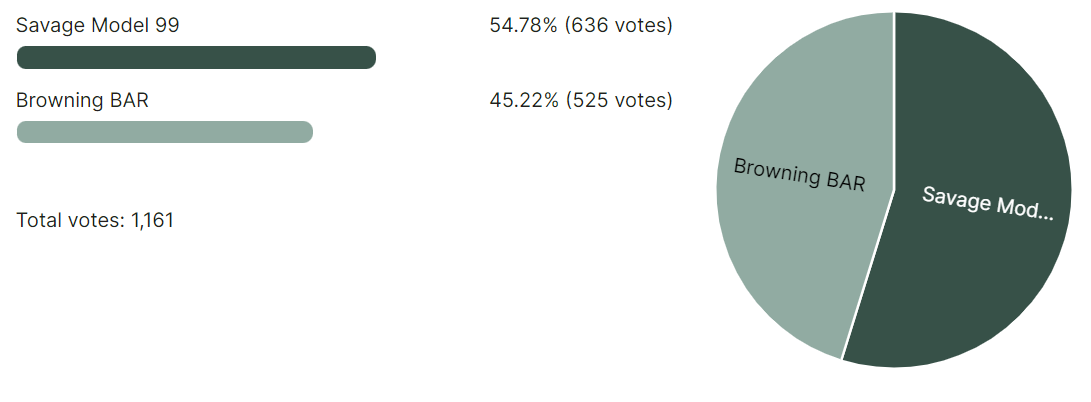
Voting for this matchup has concluded, and the Savage Model 99 is the winner!

------------------
October Madness is back! This year, we're picking the greatest deer rifle of all time. And by "we," we mean "you." Scroll down to the poll at the bottom of this article to cast your vote, and the rifle with the most votes by 11:59pm on Tuesday, October 1st will advance to the next round. If you'd like a little more information before casting your vote, check out the cheat sheets on each rifle below. And feel free to explain your vote in the comments (or why the other side is dead wrong).

Don’t forget to vote in the other matchups, which you can do here.
History
Named after the year it was conceived, the Savage Model 1899 (eventually shortened to Model 99 in 1921) was a highly innovative hunting rifle for the turn of the twentieth century. It sported an internal hammer, cocking indicator, and brass round counter on the side of the receiver. Also, unlike its tube-fed contemporaries, the 99’s rotary style magazine allowed for spitzer style bullets, so it wasn’t limited to flat nose cartridges like the Winchester 94 or Marlin 336.
In fact, shortly after WWI, Savage introduced the .300 Savage, which boasted the same ballistic performance as the .30-06 at that time. The .300 Savage skyrocketed, and other gun manufacturers took advantage of Savage’s brainchild. While it’s still a solid hunting round today, the rise of the .308 sealed its future in obscurity.
Features
The M99’s rotary style magazine immortalized this rifle, but other features made it one of the best hunting rifles of all time. Internally, the 99’s lever connects to a breech block that locks the action as the lever is closed. This solid action allowed for high-pressured cartridges. Rather than a typical “brush gun,” the Savage 99’s design made it a lever action capable of impressive ballistic feats for the time.
The cocking indicator, round counter, and lever-locking safety were a few other innovative trademarks of the M99 that made (and still make) sense for a big woods hunting rifle.
Even the fit and finish of the M99 scream deer hunting rifle. The two-part stock, which features a separate fore-end and buttstock, make shouldering the rifle comfortable and natural. The metal, rounded receiver also sits nicely in your hand, which makes it a joy to tote, so much so, that I removed the sling that came with the M99 I bought.
Availability
Savage discontinued the M99 in 1997. By then, the company had changed hands multiple times since its inception, and the rising costs made it impractical to continue their beloved lever action.
While Savage probably won’t resurrect the M99, there are plenty of used ones floating around gun shops across the country. If you’re in the market for one, don’t expect to find a decent M99 for less than $800, and immaculate ones can run double that. It’s a lot of cash for a rifle that begs for hard hunting, but I can’t think of a rifle that’s more fun to deer hunt with.
History
The original Browning Automatic Rifle (BAR) was designed near the end of WWI by (you guessed it) John Moses Browning. It was commissioned by the U.S. Army with the intention of giving American GIs an edge in brutal trench warfare. The light machine gun was chambered in .30-06 Springfield and was used as a Squad Automatic Weapon from 1918 until the end of the Vietnam War.
The sporting version of the rifle wasn’t released until 1967 and swapped the machinegun’s automatic fire for a semi-automatic mechanism. The rifle’s design remained largely unchanged until 1993, when Browning released the Mark II version of the BAR, which is still in production today (along with the even newer MK 3).
Features
The Mark II boasted significant upgrades in terms of reliability and accuracy. The robust action allows the company to chamber the semi-auto in magnum cartridges, and it retains the classic stylings of the hinged floorplate magazine. The trigger isn’t anything to write home about, but the rifle is surprisingly accurate for a non-AR-type semi-auto.
More recently, Browning released the MK 3 version of the BAR. It’s about a half-pound lighter than previous iterations and features a precision alloy receiver and a hammer-forged barrel, which promises to improve accuracy even further. Some models also feature detachable box magazines for quick reloading.
Availability
You can get a brand-new Belgium-made Portugal-assembled BAR MK 3 in several barrel and stock configurations–including the utilitarian Stalker, the camoed Ovix, and the classic wood-stock MK 3. By most standards, the rifles ain’t cheap. MSRP’s range between $1,200 and $1,900, so you’ll pay a couple hundred less at the gun store. Older models can be found in that price range, but since some are collectible, they can also be considerably more.











Conversation